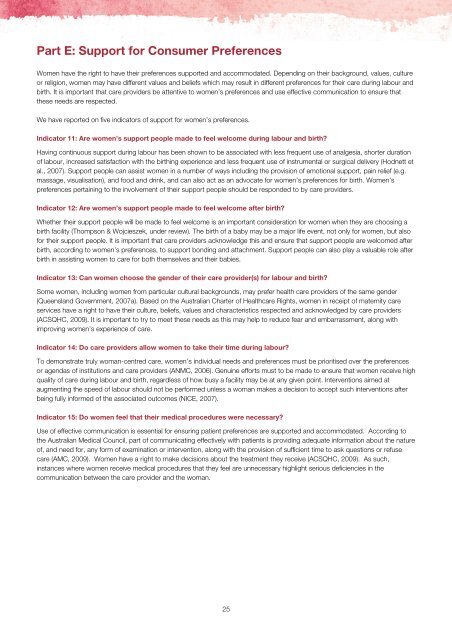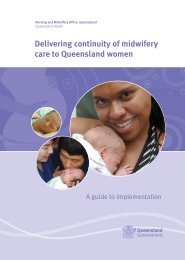Mater Misericordiae Hospital Gladstone - Queensland Centre for ...
Mater Misericordiae Hospital Gladstone - Queensland Centre for ...
Mater Misericordiae Hospital Gladstone - Queensland Centre for ...
You also want an ePaper? Increase the reach of your titles
YUMPU automatically turns print PDFs into web optimized ePapers that Google loves.
Part E: Support <strong>for</strong> Consumer PreferencesWomen have the right to have their preferences supported and accommodated. Depending on their background, values, cultureor religion, women may have different values and beliefs which may result in different preferences <strong>for</strong> their care during labour andbirth. It is important that care providers be attentive to women’s preferences and use effective communication to ensure thatthese needs are respected.We have reported on five indicators of support <strong>for</strong> women’s preferences.Indicator 11: Are women’s support people made to feel welcome during labour and birth?Having continuous support during labour has been shown to be associated with less frequent use of analgesia, shorter durationof labour, increased satisfaction with the birthing experience and less frequent use of instrumental or surgical delivery (Hodnett etal., 2007). Support people can assist women in a number of ways including the provision of emotional support, pain relief (e.g.massage, visualisation), and food and drink, and can also act as an advocate <strong>for</strong> women’s preferences <strong>for</strong> birth. Women’spreferences pertaining to the involvement of their support people should be responded to by care providers.Indicator 12: Are women’s support people made to feel welcome after birth?Whether their support people will be made to feel welcome is an important consideration <strong>for</strong> women when they are choosing abirth facility (Thompson & Wojcieszek, under review). The birth of a baby may be a major life event, not only <strong>for</strong> women, but also<strong>for</strong> their support people. It is important that care providers acknowledge this and ensure that support people are welcomed afterbirth, according to women’s preferences, to support bonding and attachment. Support people can also play a valuable role afterbirth in assisting women to care <strong>for</strong> both themselves and their babies.Indicator 13: Can women choose the gender of their care provider(s) <strong>for</strong> labour and birth?Some women, including women from particular cultural backgrounds, may prefer health care providers of the same gender(<strong>Queensland</strong> Government, 2007a). Based on the Australian Charter of Healthcare Rights, women in receipt of maternity careservices have a right to have their culture, beliefs, values and characteristics respected and acknowledged by care providers(ACSQHC, 2009). It is important to try to meet these needs as this may help to reduce fear and embarrassment, along withimproving women’s experience of care.Indicator 14: Do care providers allow women to take their time during labour?To demonstrate truly woman-centred care, women’s individual needs and preferences must be prioritised over the preferencesor agendas of institutions and care providers (ANMC, 2006). Genuine ef<strong>for</strong>ts must to be made to ensure that women receive highquality of care during labour and birth, regardless of how busy a facility may be at any given point. Interventions aimed ataugmenting the speed of labour should not be per<strong>for</strong>med unless a woman makes a decision to accept such interventions afterbeing fully in<strong>for</strong>med of the associated outcomes (NICE, 2007).Indicator 15: Do women feel that their medical procedures were necessary?Use of effective communication is essential <strong>for</strong> ensuring patient preferences are supported and accommodated. According tothe Australian Medical Council, part of communicating effectively with patients is providing adequate in<strong>for</strong>mation about the natureof, and need <strong>for</strong>, any <strong>for</strong>m of examination or intervention, along with the provision of sufficient time to ask questions or refusecare (AMC, 2009). Women have a right to make decisions about the treatment they receive (ACSQHC, 2009). As such,instances where women receive medical procedures that they feel are unnecessary highlight serious deficiencies in thecommunication between the care provider and the woman.25
















